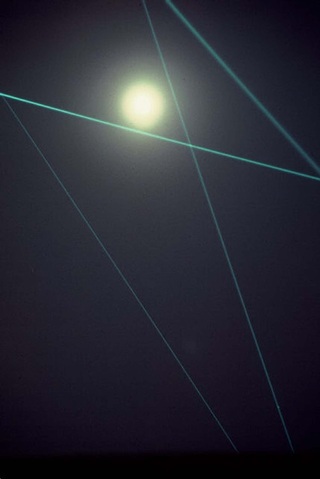Urban-Scale Laser Sculptures
"I think of these as pieces which you experience in total but
see only in sequence or passages. The experience is a remembered
experience, almost as a piece of music of which you hear the progression.
In this case, you see the progression of the piece and your final total experience
is one of memory." Rockne Krebs, 1970
"Rockne Krebs principally sculpts with light, though he has worked in a variety of media. His objective is to define space and mark time. Though some hardware is always necessary to his sculpture, the work itself consists only of light. The light generally takes two forms, one natural, the other technological. Working with the existing landscape, he transforms it, playing the variability of light conditions against a formally rigorous system of mirrors and laser lights. This creates structures which appear solid and stable, but are actually immaterial and subject to atmospheric conditions."
Reid, James Earl. Sculpture Today/Traditonal and Non-Traditional, exhibition catalogue, 1980. The Art Gallery, University of Maryland, College Park, MD.
Reid, James Earl. Sculpture Today/Traditonal and Non-Traditional, exhibition catalogue, 1980. The Art Gallery, University of Maryland, College Park, MD.
"In the 1960’s lasers became available to the artist. Lasers have been used most characteristically to create spectacular nocturnal displays, the pioneer in this field being the American artist, Rockne Krebs (1938-2011)."
Chilvers, Ian (Editor). “Light Art,” A Dictionary of 20th Century Art, 1999.
Chilvers, Ian (Editor). “Light Art,” A Dictionary of 20th Century Art, 1999.

The Source, 1980. Washington, DC.
‘Rockne Krebs is recognized as one of Washington’s
finest artists. Krebs “Of the 38 major pieces I’ve made
in the last 10 years, two still exist. Perhaps I ought to
start making still-lifes of flowers.”’
Richard, Paul. The Washington Post, October 2, 1977,
Making It as An Artist.
"The Source by Rockne Krebs, a kind of weightless sculpture made of glowing laser beams that floated in the evenings above the greensward of The Mall, was among the most beautiful.”
Richard, Paul. The Washington Post, March 27, 1990,
Sculptors’ Conference to Return to Washington.
"In his homage to the founding fathers of our country, entitled “The Source,“ Rockne Krebs bounced a laser beam off the reflecting pool between the Lincoln Memorial and the Washington Monument.” (10’ x 4' mirror in the middle of the reflecting pool.)
Editors. Optics & Photonics News, OPN, March 1996, Vol.7 No.3, After Image.
“The approval of more than ten federal agencies was required before the artist could complete this sculptural work using two argon lasers with split beams to connect the Lincoln Memorial, Washington Monument, Jefferson Memorial, and the White House.”
Public Art Proposals, 1992. Published by the International Contemporary Art Fair, Japan. Chapter: Cities and Art, Rockne Krebs, The Source, National Mall, Washington, D.C., USA, International Sculpture Center.
Public Art Proposals, 1992. Published by the International Contemporary Art Fair, Japan. Chapter: Cities and Art, Rockne Krebs, The Source, National Mall, Washington, D.C., USA, International Sculpture Center.
|
“…laser artist Rockne Krebs was the pioneer in the orchestration of elaborate choreographies of static and moving laser beams. Inclined Planes transformed the town into a dynamic stage of moving shapes.” Houk, Pamela. Sculpture, May-June 1991. Sky Art’s Lofty Ambitions. "Rockne had that ability, to hold people spellbound. I remember him at a sculptors’ conference in Huntsville, Alabama, he was just remarkable. Making those lasers come to life through 35mm slides and the power of his conviction." William Dunlap, May 14, 2013 |
|
“I was working at the Philadelphia Museum of Art back in 1973, when David Katzive, the head of the Museum's Division of Education and the Urban Outreach Program, commissioned Sky Bridge Green, which was one of the most extraordinary, beautiful artworks I have ever experienced. I watched Rockne tinker with the impressively huge laser that he had set up on the east portico of the Museum to shoot a beam of light straight down the Benjamin Franklin Parkway to a mirror on Billy Penn's hat on the top of City Hall.” William F. Stapp, December 2, 2012 Former Curator of Photography, The National Portrait Gallery Former Staff Lecturer Education Department, The Philadelphia Museum of Art |
The Tampa Tribune, November 6, 2013,
1977 artist’s work debunks rumor of UFO in St. Pete, by Paul Guzzo
Documentation of a 1977 installation by laser artist Rockne Krebs was recently mistaken for documentation of a UFO landing. A Florida newspaper debunks the myth.
Slides by Rockne Krebs, taken between 1975-1977 of his work,
The Laser and Star Board Home on the Range, Part VI, St. Petersburg, FL.
Slides were taken with long exposures at night; the effects have an ethereal quality.
The Laser and Star Board Home on the Range, Part VI, St. Petersburg, FL.
Slides were taken with long exposures at night; the effects have an ethereal quality.
The One Night Stand, Rockne Krebs, December 31, 1977 - January 1, 1978
Inner Harbor, Baltimore, MD.
Fireworks by Zambelli
First time ever lasers and fireworks shown together.
Still Green, Rockne Krebs, 1979, The Disneyland Hotel, Anaheim, CA.
*The Sixth National Sculpture Conference, 1970, catalogue, National Sculpture Center, the University of Kansas, Lawrence, KS. Edited by Elden C. Tefft, published 1971. Published transcript of Krebs’ lecture.





